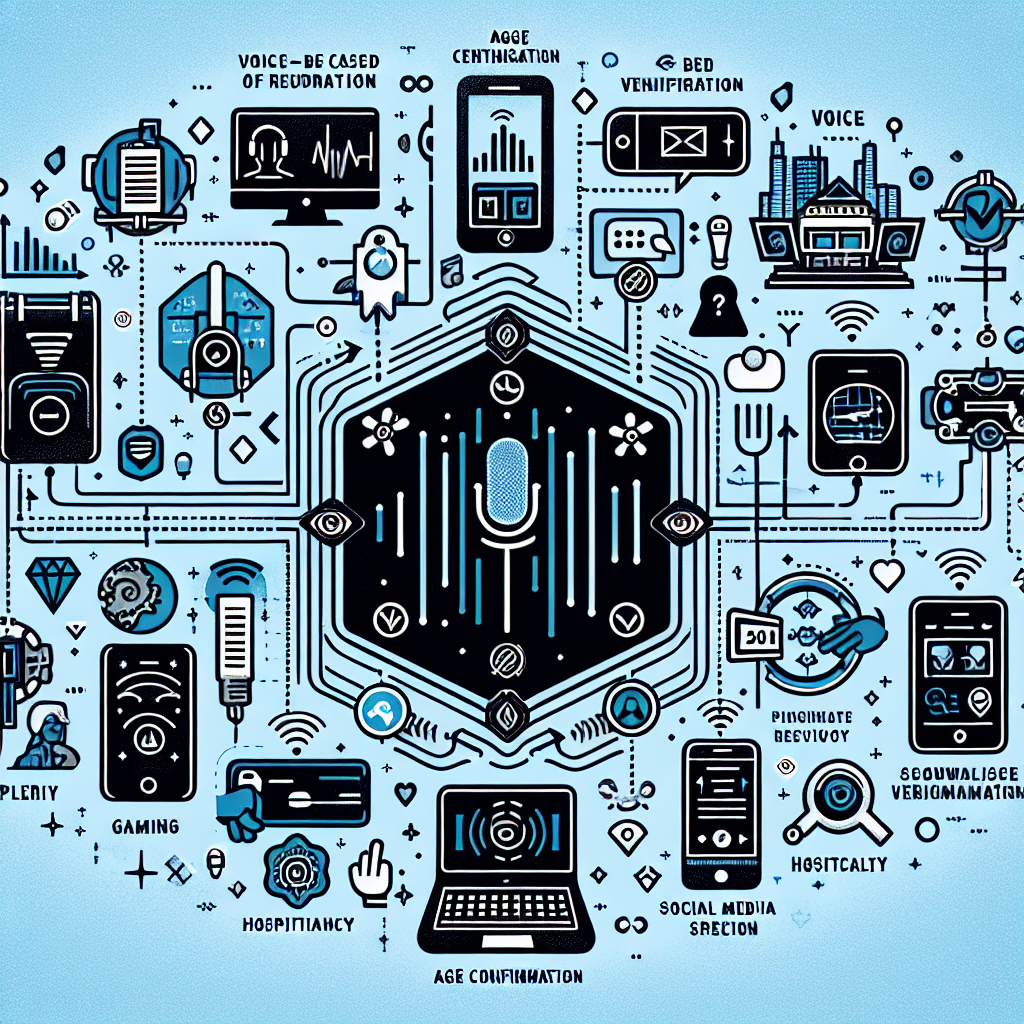
As technology continues to evolve, businesses are always on the hunt for innovative solutions to boost security, especially in the telecommunication industry. One such cutting-edge technology that has captivated the attention of forward-thinking companies is voice-based age verification.

This advanced system uses the unique characteristics inherent in one's voice to ascertain their age digitally, enhancing security in phone transactions. Biometric voice solutions, such as voice biometric technology, provide an extra layer of security that goes beyond the usual password protection, thereby dramatically reducing the risk of fraud.
To illustrate, consider a situation where an underage individual is trying to gain access to a restricted service. The conventional methods - like submitting official identification papers - can be easily bypassed using fraudulent means. However, age verification based on voice stands to be a more reliable and foolproof system.
This ground-breaking technology works by analyzing several vocal features that change predictably with age. The acoustic patterns in a person's voice significantly alter as they grow from childhood into adulthood, and these key differences are what this technology leverages to verify a user's age.
Overall, voice-based age verification acts as a powerful tool in the hands of businesses aiming to not only heighten security but also improve customer experience in phone transactions by making the verification process swift and seamless.
In the digital age where data breaches are ever more prevalent, age verification has become a security staple, particularly in telephone-based transactions. One innovative method that has recently gained traction is voice-based age verification, powered by AI and machine learning algorithms.
Voice-based age verification primarily involves three stages: voice capture, feature extraction, and matching. It's important to note that this technology doesn't just recognize the spoken words, but rather, the unique characteristics of the speaker's voice. Each of these stages plays a crucial role in the overall verification process.
Digging deeper into the first stage, your voice is captured via a microphone and converted into a digital format. The role of AI and machine learning starts becoming evident here. Special algorithms are used to preprocess and enhance the voice signal removing noise and extracting the salient features that are associated with the speaker's age.
This brings us to the next step, feature extraction. This is where the main characteristics of your voice get identified and preserved. In the context of age verification, these characteristics could include pitch, tone, speed of speech, and accent, among others. Each of these will vary according to your age, allowing these systems to take an educated guess on whether you are over a certain age threshold or not.
The final step is matching. Here, the machine learning algorithms come to play again. The digital voice sample you provided is compared against thousands or potentially millions of other voice profiles in a database. In this process, your voice and its extracted features are matched against others of a similar age group. If your voice matches those in the designated age group, the system verifies your claimed age.
Besides boosting security, this innovative method has the potential to alleviate customer service queues and enhance user satisfaction while conforming to age restriction laws. Future advancements in AI and machine learning are poised to make voice-based age verification even more efficient and accurate, influencing sectors beyond telephonic transactions.
Implementing voice-based age verification into business systems can be a smooth, effortless process, bringing both improved security and a more intuitive customer experience. By including such interactive voice response (IVR) systems into their current phone-based infrastructure, businesses can enhance their authentication process without needing substantial system alteration or additional infrastructure.

These voice verification systems can seamlessly integrate with existing phone systems. Also, by offering an application programming interface (API), they can be connected with a business’s customer relationship management (CRM) software. This makes it possible to automate the process further, offering real-time verification by direct CRM integration.
These systems do not necessitate a complete overhaul of the current operating systems. They are built to co-work with the existing technologies, making the transition almost effortless. The ease of adoption is, therefore, quite high, reducing the operational and financial burdens that often accompany the adoption of new technology.
Further, these voice-based verification systems have a high compatibility with various platforms, ensuring its utility across multiple hardware and software. This compatibility combined with the minimal infrastructure requirements ensures the voice verification system can indeed enhance the security quotient of phone transactions without disrupting the workflow.
In conclusion, businesses looking to improve the security of their telephone transactions can implement voice-based age verification seamlessly, growing their transaction safety while improving the customer experience. With its ease of integration, minimal operation costs, and high compatibility, it is a worthwhile investment for any business offering phone-based services.
In this digital age, robust security measures are no longer an added advantage, but a necessity, particularly for phone transactions. A rapidly emerging technology in this segment is Voice-Based Age Verification. This method uses biometric authentication, examining an individual's unique vocal features to ascertain their age, thus increasing security on phone transactions and providing safeguards against identity fraud.
Voice-Based Age Verification systems leverage biometric voice recognition technology coupled with artificial intelligence (AI) to authenticate the user's age. These systems have the capacity to accurately measure hundreds of voice features, including rhythm, pitch, and cadence. They employ advanced machine learning algorithms that are trained on thousands of voice samples from different age groups to accurately determine the user's age.
However, the use of such ground-breaking technology inevitably raises a number of privacy concerns. The potential misuse of personal data collected during phone transactions has been a longstanding issue. In response to such concerns, responsible providers of Voice-Based Age Verification services implement strong data protection protocols. These include anonymisation of data, secure data storage, strict access control, and ensuring transparency in data usage. The objective is to protect user privacy while enhancing security.
Industry-standard encryption protocols are implemented to ensure the integrity and confidentiality of the data. Encryption makes intercepted communication useless to hackers as the data is rendered unreadable. Furthermore, these systems also adhere strictly to international and national data protection laws - an assurance to users who may be wary of sharing personal data.
Despite these reassurances, some skepticism remains among potential users. Providers should therefore communicate transparently about their data handling practices and continually seek to innovate and bolster their security measures. As for users, they are encouraged to familiarize themselves with the terms and conditions of usage of these systems, thus playing an important role in safeguarding their personal data.
Through constant improvements and emphasis on data privacy, Voice-Based Age Verification technology holds much promise in enhancing security in phone transactions amidst the rapidly evolving digital landscape.
In the past few years, the advent of voice-based age verification technology has made a significant impact on a wide range of industries. It has effectively enhanced the security of phone transactions, thereby minimizing the risk of underage engagement in adult-focused services or purchasing of age-restricted products. Throughout various applications and case studies, the efficacy and reliability of this technology have been proven.

An illustration of the successful implementation can be seen within the gaming and gambling industry. Age verification has always played a crucial role in this field, ensuring that minors aren't partaking in gambling activities. Innovative companies have adopted voice-based age verification tools to confirm a user's age over the phone before they can place a bet. This has been seen to drastically reduce instances of underage gambling.
Another example is prevalent in the alcohol industry. Often, online or phone-based sales create an age-verification challenge. Several industry players have ingenuously adopted voice-based age verification technology to ascertain the age of the buyer over the phone before the transaction is finalized. The real-world application of this technology has greatly reduced non-compliance risks and increased operational security.
Furthermore, in the telecommunications sector, adding an extra layer of security via voice-based age verification has deterred potential underage individuals from accessing certain subscription-based services, such as adult content channels. Having this form of robust safety measure in place ensures compliance with telecom regulations and protects both the provider and the user.
In conclusion, these case studies underscore the value potential of voice-based age verification as an effective tool in enhancing security in phone transactions. As businesses continue to digitally transform, it becomes imperative to implement such robust verification processes to maintain high levels of security and compliance.
The landscape of technology is an ever-evolving canvas, ceaselessly bringing forth innovations that further secure and simplify human interactions. These inventions have been encompassing multiple fields, notably benefiting the sector of telecommunication transactions. A rising star in this domain is voice-based age verification, expected to usher a new epoch in securing phone transactions.
This technology, even at its potentially nascent stage, is already showing promising signs of maturity and sophistication. At its core, voice-based age verification uses biometric vocal characteristics to authenticate a caller's age, ensuring added security in phone transactions. A cursory glance at futuristic developments in this technology reveals an exhilarating realm of possibilities.
Future iterations of this technology are likely to incorporate artificial intelligence (AI) and machine learning more pervasively to enhance accuracy. AI in voice verification could learn and adapt to subtle changes in a person's voice over time, from natural aging or differing health conditions, improving verification reliability.
Beyond this, voice-based age verification might soon form a part of a multifactor authentication approach. Used in conjunction with other verification methods like facial or fingerprint authentication, a voice feature can substantially augment the security accorded to phone transactions. These potential applications can be discovered in more depth here.
Besides, some proponents of voice-based age verification applications envision its use across a broader spectrum, beyond just phone transactions. This could range from authenticating online game players to ensuring age-appropriate access to certain digital content, significantly expanding its reach and utility.
Undeniably, voice-based age verification holds a vast untapped potential in the sphere of technological advancements, promising a future of more protected and seamless transactions. The onus now lies on technologists, businesses, and policymakers to harness these trends wisely and ethically, ushering in a safer digital world.
Start your free trial for My AI Front Desk today, it takes minutes to setup!








